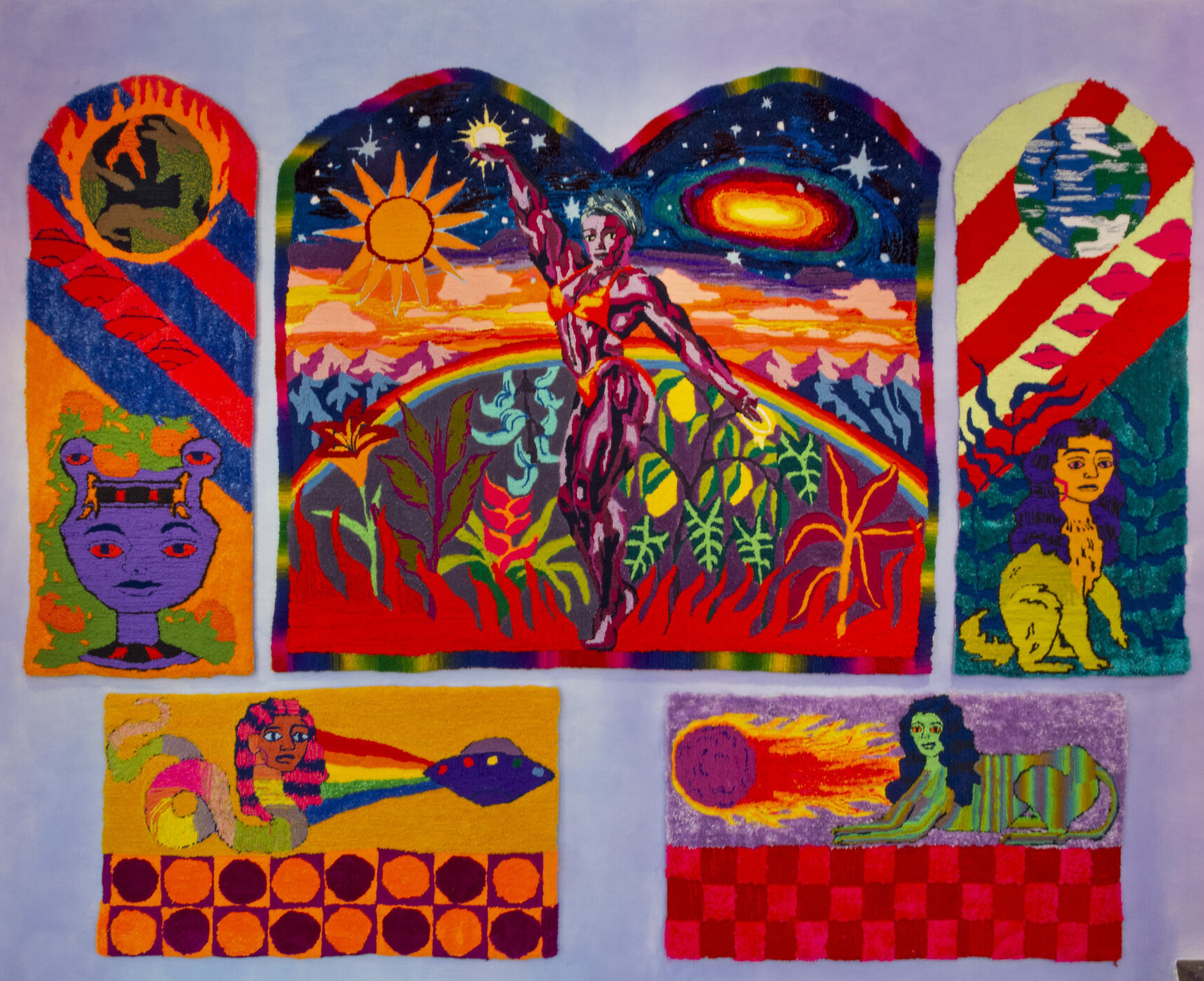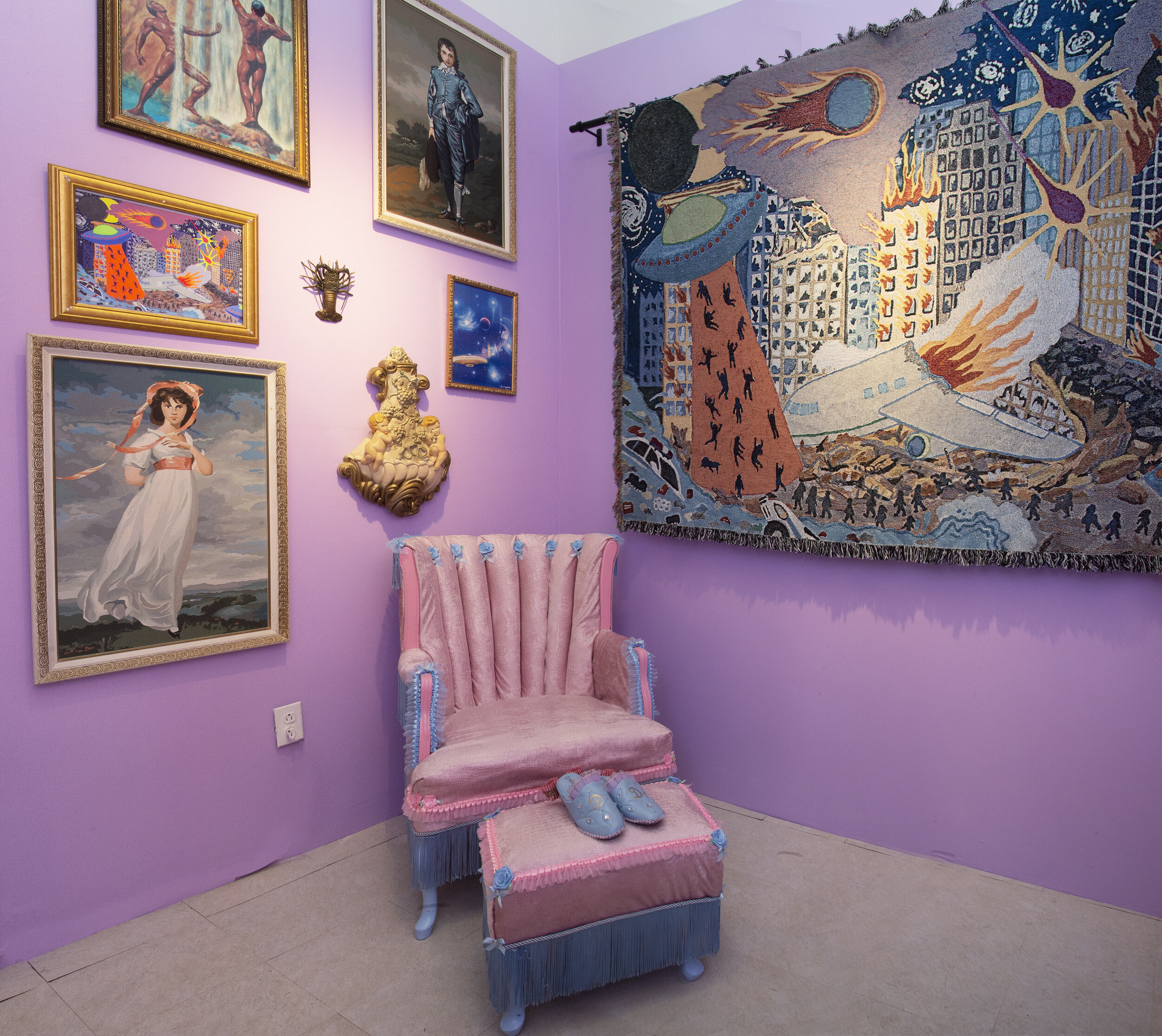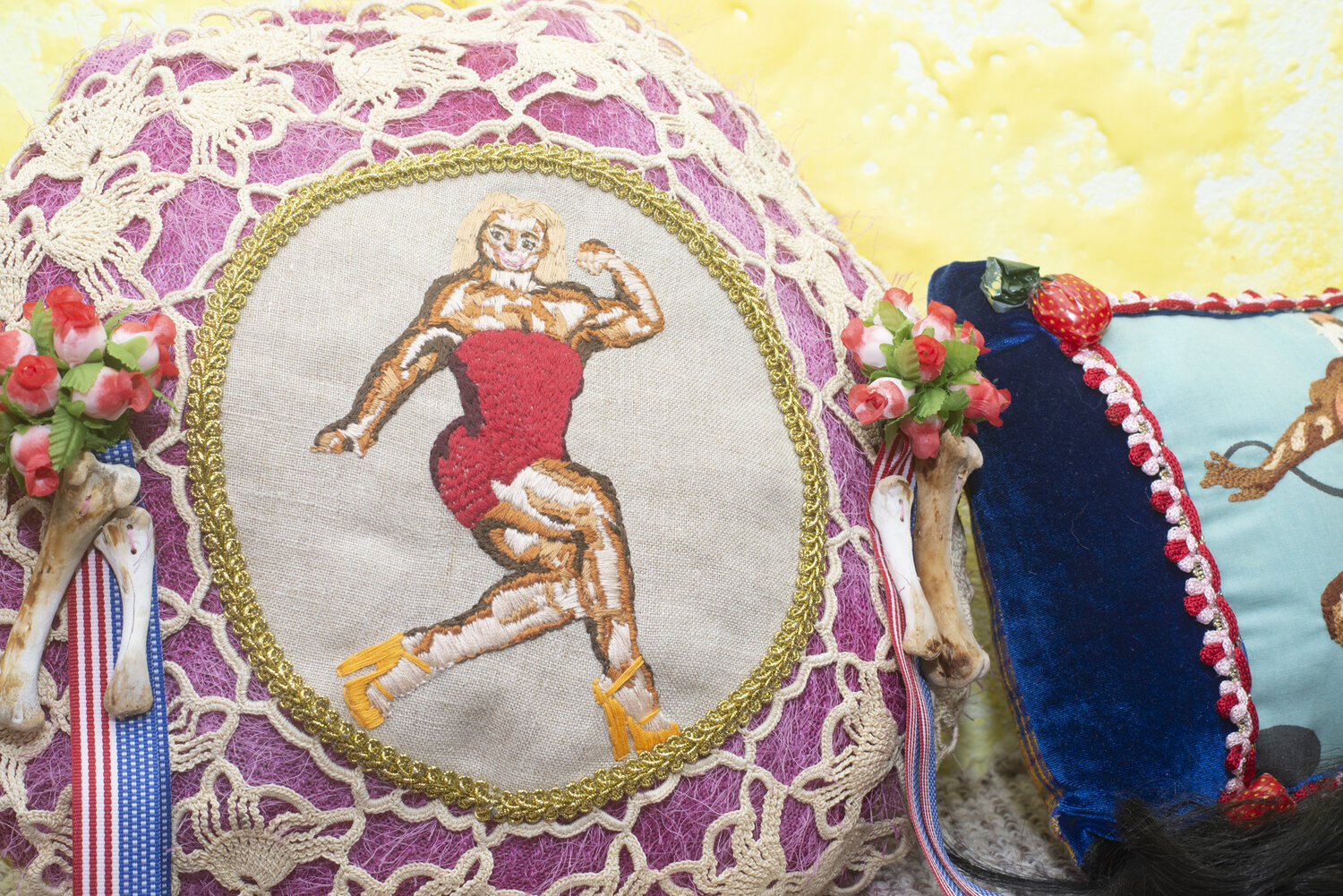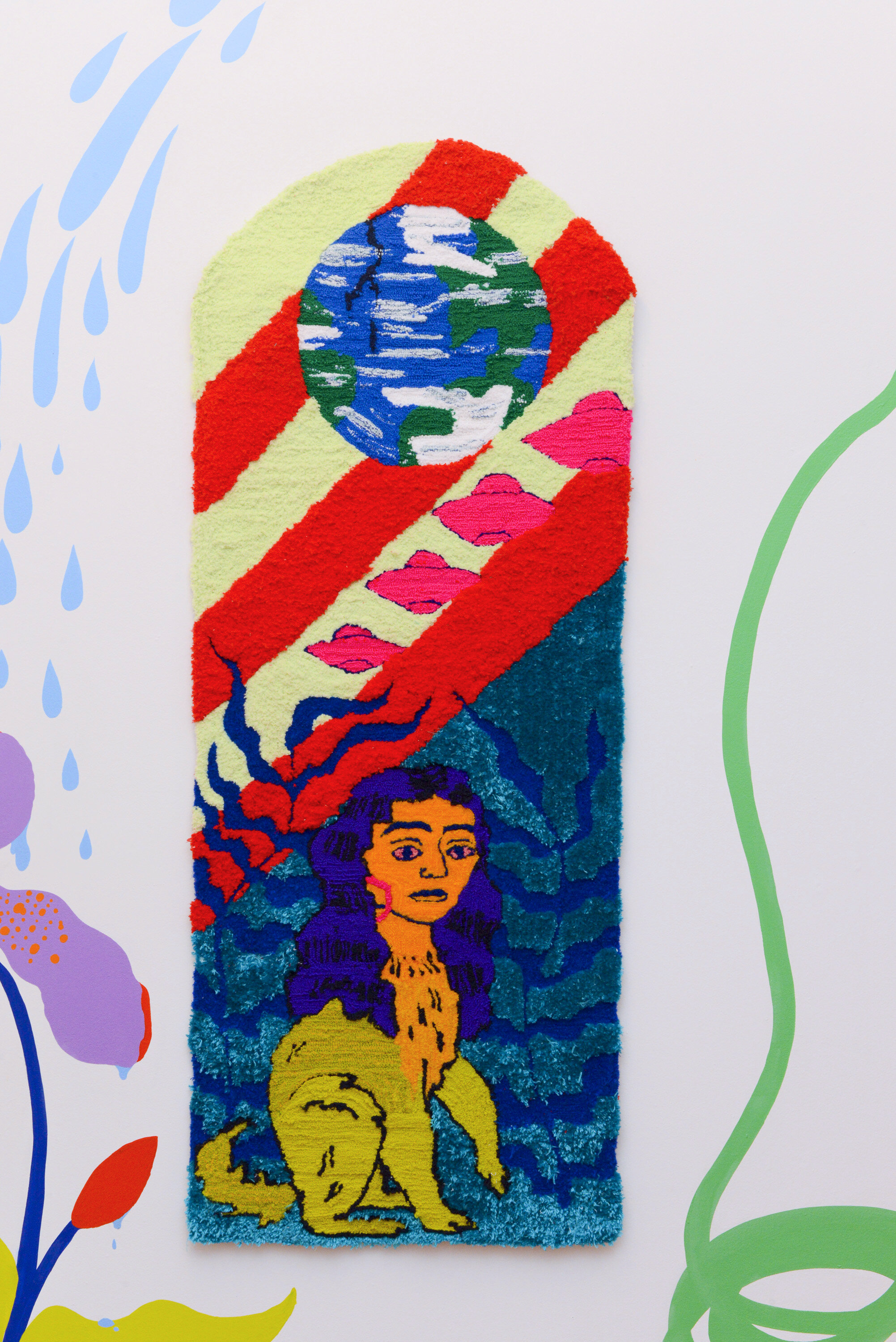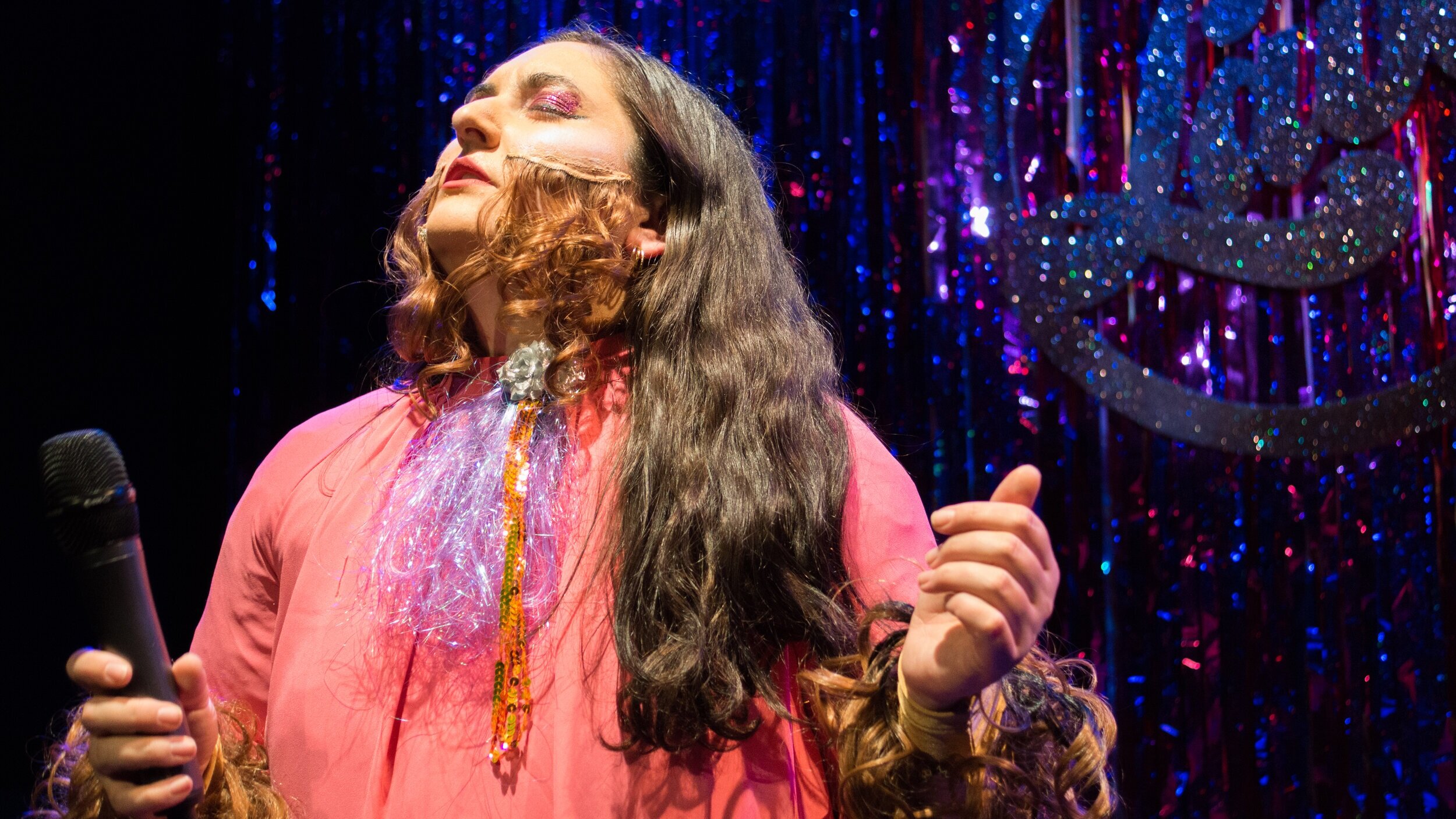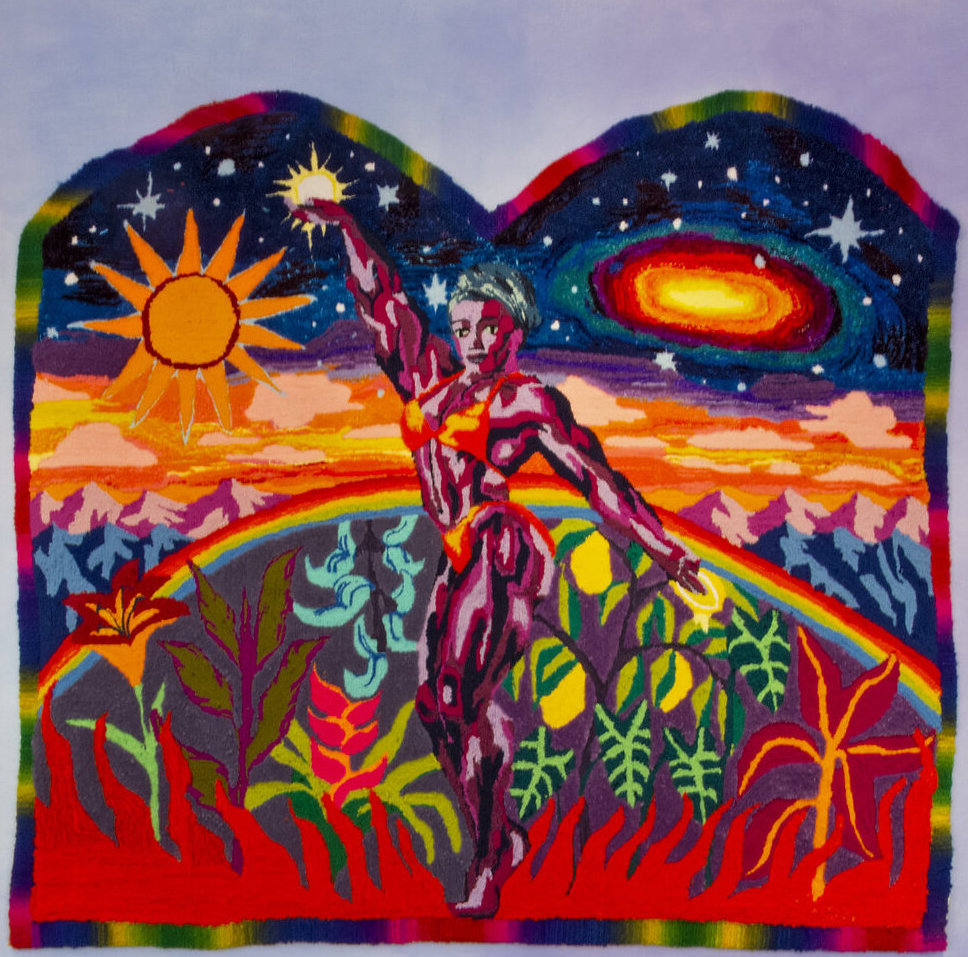Brooklyn-based Tura Oliveira is a multi-disciplinary artist working in textile, video, installation, music, and performance. Oliveira’s work draws from influences as diverse as Walter Mercado, Pieter Bruegel, John Waters, and Ursula K. Le Guin to explore concepts of labor, utopia, and performativity.
Oliveira’s installations evoke contemplation within devotional spaces and imagine a future of leisure, pleasure, and beauty.
We talk bourgeois concepts of good taste, The Bachelor, the capitalist failure of imagination, and wampum.
![]()
Mundo Irrealis (Wish You Were Here), 2019,
Installation with hand-tufted rugs, video, hand-dyed fabric on found furniture, candles, incense, digital prints on satin, and fluid acrylic
Rose & Thorn?
My rose is that I’m at a beautiful residency, which is really wonderful. And my thorn is that I'm at a residency and away from New York and my friends, so the rose and the thorn are the same thing, because it's really nice to be here but I would like to see my friends.
How long are you there for?
A month, so I'm here until Memorial Day weekend.
Can you tell us a little bit about the show [“I Saw God and...” (2021)]?
The show up at BRIC is the culmination of a year of work. It's all textile pieces, along with murals, that are related to an ongoing series of work that is set in a science-fiction, apocalyptic utopia. I’m thinking about the installations as devotional spaces, and the works themselves as artifacts and devotional objects.
There's that Muñoz quote in the beginning of the press release, and, obviously, there's the idea of a queer utopia and similar kinds of concepts.
Can you talk about how the images and symbols might relate to a queer utopia?
Can you talk about how the images and symbols might relate to a queer utopia?
There are symbols that come up over and over again, one being the abstracted eroticism of fruit and plants. In the show there's this big, velvet, pussy-flower sculpture. I was thinking about a future where the lines between the human world and the plant world are significantly blurred.
In the work, images of leisure are important, which is also an easy shorthand for depicting utopia, Breughel does that, it's an easy shorthand for something between utopia and heaven, but it also throws our current lives, when our time on earth is increasingly whittled down and optimized for creating profit for somebody else, into sharp contrast with these images.
In the work, images of leisure are important, which is also an easy shorthand for depicting utopia, Breughel does that, it's an easy shorthand for something between utopia and heaven, but it also throws our current lives, when our time on earth is increasingly whittled down and optimized for creating profit for somebody else, into sharp contrast with these images.
![]()
Oxalá, Pois vejo vir vindo no vento, Cheiro de nova estação, Eu sinto tudo na ferida viva, Do meu coração (I wish, For I see coming in the wind, Smell of a new season, I feel everything in the living wound, From my heart), 2020-21
hand-dyed silk velvet, wood, chicken wire, tufted acrylic, wool, and cotton 45 x 45 x 30 in.
The velvet flower work looks like a dress–is it purposefully designed like that?
It is not something that I thought of while making it, but I did want it to feel bodily in terms of just being this thing that is basically the height and scale of a person, (it’s almost five feet tall), and also bodily in the terms of looking like an orifice. If you look at it from the side it looks like it has a bustle or an ass, which is fun and exciting to me.
I always forget about the association of clothing with my work, because textiles are sort of a baseline medium for me; the jumping off point for almost everything that I do. Clothing is just one part of how these things relate to the body, not only clothing, but also quilts which are scaled for beds and bodies.
I always forget about the association of clothing with my work, because textiles are sort of a baseline medium for me; the jumping off point for almost everything that I do. Clothing is just one part of how these things relate to the body, not only clothing, but also quilts which are scaled for beds and bodies.
Quilts are very much built around community and family while also providing warmth and comfort.
Is that something that's on your mind when you're making them?
Is that something that's on your mind when you're making them?
I've been thinking about quilts being very spiritual objects in that they are built to outlive you, and they’re also meant to be shared and to provide care. I think that they're especially spiritual in that they have to do with unmaking and remaking. I'm looking at this table right now where I'm cutting fabric and there's a weird finality and mortality of the fact that you can't undo a cut that you've made in a piece of fabric, you can sew it back together, but the cut is irreversible, although you can remake it into something new.
The practice of quilting, in general, has a spiritual quality because of the process that’s involved and the fact that they outlive us?
I think about quilting as the act of a needle piercing a substrate over and over and over again, and that act as also piercing the veil between worlds, the past and the future, and separations between the natural world and the world of human beings, cutting and mending, unmaking and remaking.
Between your practices in performance and visual art, did one start before the other one, and how did they become this dual practice?
I went to school for visual art. There was another school very close by that has a really great theater and performance studies program. So I started doing them around the same time. Even in high school I was doing a lot of theater and I was doing a lot of visual arts, and at the time they felt very separate.
When I first moved to New York, I didn't have a studio and I didn't really have time to make objects. I was working all the time, and then doing nightlife performances. There's that punk aspect of it, you're putting together something out of nothing, and to me, that is related to the quilting practice.
They inform one another. When I make visual art or when I do performance art it’s a reflection of when I have resources that are being offered to me.
When I first moved to New York, I didn't have a studio and I didn't really have time to make objects. I was working all the time, and then doing nightlife performances. There's that punk aspect of it, you're putting together something out of nothing, and to me, that is related to the quilting practice.
They inform one another. When I make visual art or when I do performance art it’s a reflection of when I have resources that are being offered to me.
![]()
The vessel and the blood boiling into air between us, Kissing we were breathing, And dying from the temporary ecstasies, we let go, Into the depths of one another, Go, We went, We sang, And God, Was a feeling we gave to ourselves (detail), 2020,
cotton and Rayon Jacquard weaving, hand dyed cotton, cotton batting, 47 x 108 inches
Piggybacking off of that and some of your earlier works like the bachelor performance [“Everything Happens for a Reason”], “Delilah” (2015), and “Labor in Vain,” there does seem to be a reliance on humor while dealing with heavy subject matter.
What is the importance of humor for you?
What is the importance of humor for you?
I think it's something that has to exist. I also think that joy and humor is so much about imagining a future in dire circumstances, and in that way joy and humor are radical things. Finding them, especially in performance, is really important, it's almost like salt in cooking. It's something that is so necessary, I almost don't even think about it. It's just like, “Oh, it's seasoning, it's necessary for the making of anything.”
That goes into the concept of irony–which is really the salt of drag–as well as the queer appropriation of mainstream culture as this way of coping with the ugly truth of things.
Do you have irony and humor in mind when thinking about a queer utopia?
Do you have irony and humor in mind when thinking about a queer utopia?
I think about John Waters and his sensibility as a touchstone in my work. Thinking about doing things, not necessarily ironically, but doing things that are in poor taste, things that are in playful confrontation and humorous opposition to good taste, to bourgeois ideas of both behavior and aesthetics, and trying to embody that.
Even like, “What color choice can I make that is the most oppositional to bourgeois ideas of good taste?” There's this very capitalist, minimalist, good taste that's being marketed pretty heavily to us right now.
And it's partially because the world is so chaotic and messy, and this lifestyle that’s being pushed right now is like, “What if everything was smooth and poreless and frictionless.” It’s related to that feeling of being whittled down that I was talking about earlier. And I understand it; I also like my apartment to be clean. But I’m trying to make performances or objects that are humorously rejecting those things.
Even like, “What color choice can I make that is the most oppositional to bourgeois ideas of good taste?” There's this very capitalist, minimalist, good taste that's being marketed pretty heavily to us right now.
And it's partially because the world is so chaotic and messy, and this lifestyle that’s being pushed right now is like, “What if everything was smooth and poreless and frictionless.” It’s related to that feeling of being whittled down that I was talking about earlier. And I understand it; I also like my apartment to be clean. But I’m trying to make performances or objects that are humorously rejecting those things.
![]()
Dick Van Dick: Everything Louder Than Everything Else, 2018,
jacquard weaving, hand-poured candles, altered furniture, acrylic on velvet, gouache on paper, found and fabricated objects
Your performance and drag personas are definitely not sleek-chic, they toe the Waters line.
Maybe when I’m dead, maybe the pendulum swings back.
Then it’ll all be about maximalism!
Yeah, exactly.
In dealing with drag, as well as with your Bachelor performance, you raise questions of authenticity, and whether or not such a thing is possible.
It's interesting... The Bachelor is a special kind of drag [laughs]. Everybody in this show is doing drag as, like, someone's idea of what a person even is, what heterosexual romance is. It's so wrapped under all of these layers of perception and performance.
“I always say that The Bachelor is one of the only shows on television where I can just watch 25 women sitting in a room together talking about their feelings.”
There’s the question of who has the power in a given situation, but I always say that The Bachelor is one of the only shows on television where I can just watch 25 women sitting in a room together talking about their feelings. It's all centered around a man, but it's almost not even about him. It's about the idea of love, this very commercial idea of love.
Are you playing off of that with Dick Van Dick at all, this mainstream idea of manhood?
Dick van Dick is kind of a Liberace or Walter Mercado, he’s not this drag king who’s sexy, hyper masculine, smoking cigarettes, etc. And that's very hot, and great, and I love super masc drag kings, but I wanted this idea of a really flamboyant masculinity that could be a way of performing gender that I do not have access to in my daily life, this flavor of masculinity that is very campy and gay, flipping capes around, things like that.
And that is weirdly circling back to queerness and masculinity; I mostly sing Meat Loaf songs [laughs], in which all the imagery is motorcycles and hellfire, but it's also really operatic and campy. I like this looping back between masculinity and femininity.
And that is weirdly circling back to queerness and masculinity; I mostly sing Meat Loaf songs [laughs], in which all the imagery is motorcycles and hellfire, but it's also really operatic and campy. I like this looping back between masculinity and femininity.
![]()
Fourth Dimensional Dandy,
ongoing performance series
To touch on some of your earlier visual art with “You Never Know It Might Just Be You!” (2017) and then “Labor in Vain” (2016), what was the selection process for the objects, in terms of the lemon, the chicken bones, or the shells specifically? Is that pointing back towards the use of shells as currency?
Ok, this is one of my favorite things to talk about–are you referring to wampum?
Yeah.
Because the perception of wampum as currency is from white colonizers coming and seeing the way that wampum was regarded, and having a perception of it from an extremely capitalist culture, coming from the birthplace of capitalism and being like, “this is money, we understand this, these things that are regarded with value are currency.”
And wampum’s actual role is actually something much more complex, a part of a gift economy, a culture of mutual reciprocity, interconnectedness through ancestry and name and narrative, and that is something that I think about constantly.
And wampum’s actual role is actually something much more complex, a part of a gift economy, a culture of mutual reciprocity, interconnectedness through ancestry and name and narrative, and that is something that I think about constantly.
![]()
Labor in Vain, 2016,
hand-embroidered pillows, puff paint, sequins, found objects, carpeting
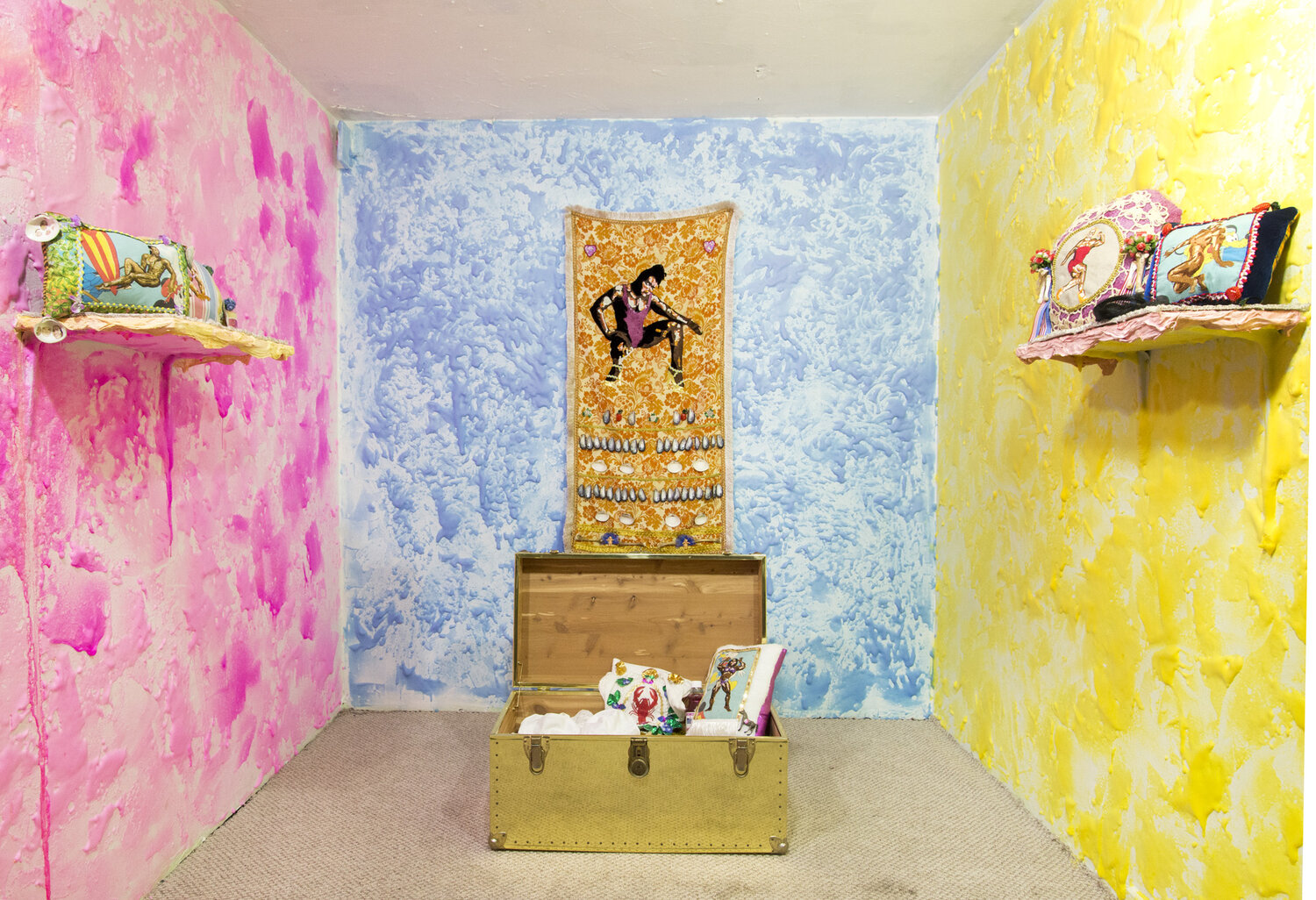
Labor in Vain, 2016,
hand-embroidered pillows, puff paint, sequins, found objects, carpeting
“I think our inability to imagine the world in different ways and in this particular case, imagining value and systems of value in a radically different way is a planned aspect of capitalism.”
I'm thinking of that specific example of the misinterpretation of wampum as currency as a violent, capitalist failure of imagination, because I think about imagination a lot in my work.
As much as I cringe slightly at that word, because it has been so “Disneyfied”, I think our inability to imagine the world in different ways and in this particular case, imagining value and systems of value in a radically different way is a planned aspect of capitalism.
Our stunted imaginations are by design!
I'm collecting seashells in my studio right now. There are these mussel shells that are really worn down, because the tides here are really extreme, and the black outside of the mussel shells is getting worn down so you can kind of see that blue.
Especially with the chicken bones; things like food scraps are abject scraps of domestic food consumption, and this idea that, again, these are things that are supposed to be spirited out of our kitchen in a frictionless world and we never see them again. The idea of turning them into decorative aspects of these objects is exciting to me.
Especially with the chicken bones; things like food scraps are abject scraps of domestic food consumption, and this idea that, again, these are things that are supposed to be spirited out of our kitchen in a frictionless world and we never see them again. The idea of turning them into decorative aspects of these objects is exciting to me.
![]()
Labor in Vain (detail), 2016
Around 2017 and 2018, there's a big thematic shift between the work you did before and after. The Bachelor performance and Delilah are focused on aspects of the present and our current culture, then it kind of feels as if there's a big shift towards ideas of imagined utopias, a shift in the timespan you're looking into. You start bringing in these mythologies and imagined sci-fi futures, this queering of time where there's less of a boundary between the ways you think about the past and the future. Do you see this as well?
Yeah, I think that is definitely a correct reading. I think 2017 and 2018 were kind of hard years for me; I had two friends who died a year apart from one another, and I hadn't thought about this as being the catalyst for that, but I think it definitely had me thinking about the afterlife, and about how that relates to our limited imagination about ways that we can transform the world.
It's easier, I think, for us to imagine a heavenly space in which we are reunited with people that we have lost, and that there's no work, just pleasure and beauty, and all of this stuff.
It's easier, I think, for us to imagine a heavenly space in which we are reunited with people that we have lost, and that there's no work, just pleasure and beauty, and all of this stuff.
![]()
The Party Is Para Todos (detail), 2019,
hand tufted rugs, video, murals
“Why is it easier for us to imagine [utopias] we can only access that through death, than to imagine actually transforming the material conditions of our present to make those material conditions a reality here on earth?”
Why is it easier for us to imagine this reality in some sort of supernatural space? Why is it easier for us to imagine that we can only access that through death, than to imagine actually transforming the material conditions of our present to make those material conditions a reality here on earth?
Thinking about death a lot and then thinking about ideas of queer mourning and survival were a big part of that shift.
Thinking about death a lot and then thinking about ideas of queer mourning and survival were a big part of that shift.
In 2017, you did the “Electrolysis Farewell Tour” with the name Lava Saudade, can you talk about that piece, and especially the name. I’ve lived with Brazilians for many years, so I'm connecting the idea of saudade with what you’ve just said.
Saudade is one of these untranslatable words, it kind of means nostalgia but it's also sadness, but it's also kind of like a pleasurable sadness.Yeah, it's very difficult to define.
It can also mean “to miss” someone or something, no?
The classic example in Fado music is a woman whose husband or lover has died at sea, but she will never know for sure if he's coming back or not. It’s missing something that you’re pretty certain you’ll never see again, it's very complicated.
That show was really fun. I want to record all of the 12 original songs in it. It was also really stressful for me; I made all the costumes, and I collaborated on the music with three or four different people, wrote the script, and all this stuff.
It was partially because I wanted to do something that was combining all of these narratives that recur in the biographies of different female pop stars, and make an amalgamation of all of the recurring narratives as a kind of contemporary mythology. This idea of taking different things from different pop stars’ lives and combining them into a super narrative.
There’s also this idea of her bordering on the supernatural, so I wore a suit that I sewed just rows and rows and rows of hair onto. But she’s also this very human person, who’s really just sad. Part of the narrative of the show is that she has been sent on this tour because she has essentially sold her body to this wellness conglomerate, who is going to do full body electrolysis on her at the end of it.
That show was really fun. I want to record all of the 12 original songs in it. It was also really stressful for me; I made all the costumes, and I collaborated on the music with three or four different people, wrote the script, and all this stuff.
It was partially because I wanted to do something that was combining all of these narratives that recur in the biographies of different female pop stars, and make an amalgamation of all of the recurring narratives as a kind of contemporary mythology. This idea of taking different things from different pop stars’ lives and combining them into a super narrative.
There’s also this idea of her bordering on the supernatural, so I wore a suit that I sewed just rows and rows and rows of hair onto. But she’s also this very human person, who’s really just sad. Part of the narrative of the show is that she has been sent on this tour because she has essentially sold her body to this wellness conglomerate, who is going to do full body electrolysis on her at the end of it.
![]()
Electrolysis Farewell Tour, 2017,
evening-length performance
Back to the concept of devotional spaces as the intersection between queerness, religion, and these imagined futures–what is the importance of creating these devotional spaces and what exactly is the division between a devotional space and a personal or public space?
I'm excited by the idea of devotional spaces as public spaces. In most of Latin America and also in Italy and Spain, if you walk around a town, for the most part, churches are just open. You can go in on your lunch break and go light a candle and pray.
The Catholic Church is not a safe public space for many many people for lots of different reasons, but thinking about them as a model for a type of public space where you can freely go that is not about engaging in commerce but that is also not a domestic space. Thinking about this future, especially when I did the installation at Wave Hill, because Wave Hill was a former private residence that is now a public arts space, but that because of its location, and lack of transit, is maybe not as public or as accessible as one might like it to be, but imagining a future in which former private homes of the wealthy are taken over and used as places for leisure and spiritual contemplation, beauty.
The Catholic Church is not a safe public space for many many people for lots of different reasons, but thinking about them as a model for a type of public space where you can freely go that is not about engaging in commerce but that is also not a domestic space. Thinking about this future, especially when I did the installation at Wave Hill, because Wave Hill was a former private residence that is now a public arts space, but that because of its location, and lack of transit, is maybe not as public or as accessible as one might like it to be, but imagining a future in which former private homes of the wealthy are taken over and used as places for leisure and spiritual contemplation, beauty.
![]()
Installation view, Mundo Irrealis (Wish You Were Here), 2019,
Wave Hill, Bronx, NY
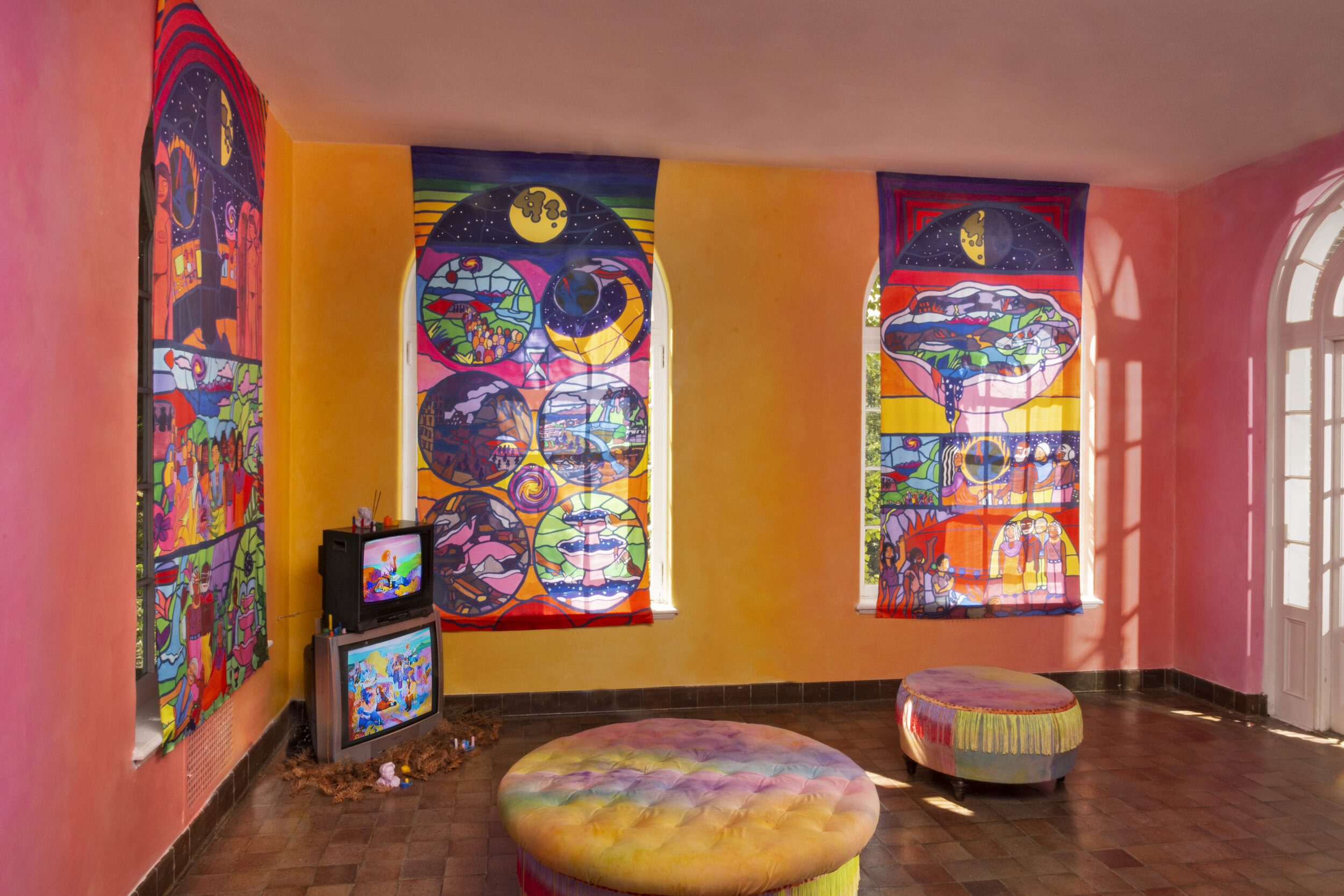
Installation view, Mundo Irrealis (Wish You Were Here), 2019,
Wave Hill, Bronx, NY
“...I am struck by this idea of non literary contemplation of objects and piecing together narratives from imagery surrounding you in a devotional space.”
I also think about how Catholic mass all used to be in Latin, which if you could’t read or understand Latin then you were basically just hearing sounds and doing the motions that you're supposed to do. So the objects, the art on the walls and on the ceilings, then take on an essential role of conveying narrative or sublime spiritual experience by non-literary means. So in making narrative and figurative objects, I am struck by this idea of non literary contemplation of objects and piecing together narratives from imagery surrounding you in a devotional space.
Can you talk about the recurring figure of the female body builder?
Well firstly, I just think that they're really beautiful. I think sometimes people are like, “Oh, you're interested for all of these reasons.” While, yes, I am interested for conceptual reasons, but there’s a significant element of queer desire for the subject.
That being said, It's also about the mutability of gender expression, of using labor to transform your body and specifically transforming the women's bodies from one shape to another through time, labor and force of will. It’s also an ascetic practice, and one that views the body as sculpture, this unstatic object with endlessly mutable gender expression
That being said, It's also about the mutability of gender expression, of using labor to transform your body and specifically transforming the women's bodies from one shape to another through time, labor and force of will. It’s also an ascetic practice, and one that views the body as sculpture, this unstatic object with endlessly mutable gender expression
Mundo Irrealis (Wish You Were Here) (detail), 2019
How do you conceptualize these notions of time that you're working with? Whether it’s from a sci-fi angle or the queering of time, what notions of time do you believe in?
I, like other people living under capitalism, am also living under colonial and capitalist notions of time. I think it is a worthwhile practice to try to understand that those notions of time are a product of global capitalist systems.
I also think that is relates to thinking about death, and not thinking about our lives as point A and then point Z, or whatever, thinking about the idea of the afterlife or as being some point in a linear progression of our lives, but that death is maybe not the end or that our future is intrinsically related to our present.
It’s giving oneself up to the idea of the infinite nature of time and consciousness and simultaneous existence of things in the universe. I think that giving up oneself to the mystery of that is important. Thinking of that as The Mystery is very Catholic, which is how I grew up, the notion that I'm a speck on the ocean of time.
I also think that is relates to thinking about death, and not thinking about our lives as point A and then point Z, or whatever, thinking about the idea of the afterlife or as being some point in a linear progression of our lives, but that death is maybe not the end or that our future is intrinsically related to our present.
It’s giving oneself up to the idea of the infinite nature of time and consciousness and simultaneous existence of things in the universe. I think that giving up oneself to the mystery of that is important. Thinking of that as The Mystery is very Catholic, which is how I grew up, the notion that I'm a speck on the ocean of time.
![]()
The Goddess, Asleep, Is Bitten by a Cosmic Snake and Thereby Hallucinates the Universe into Existence (detail), 2019-20
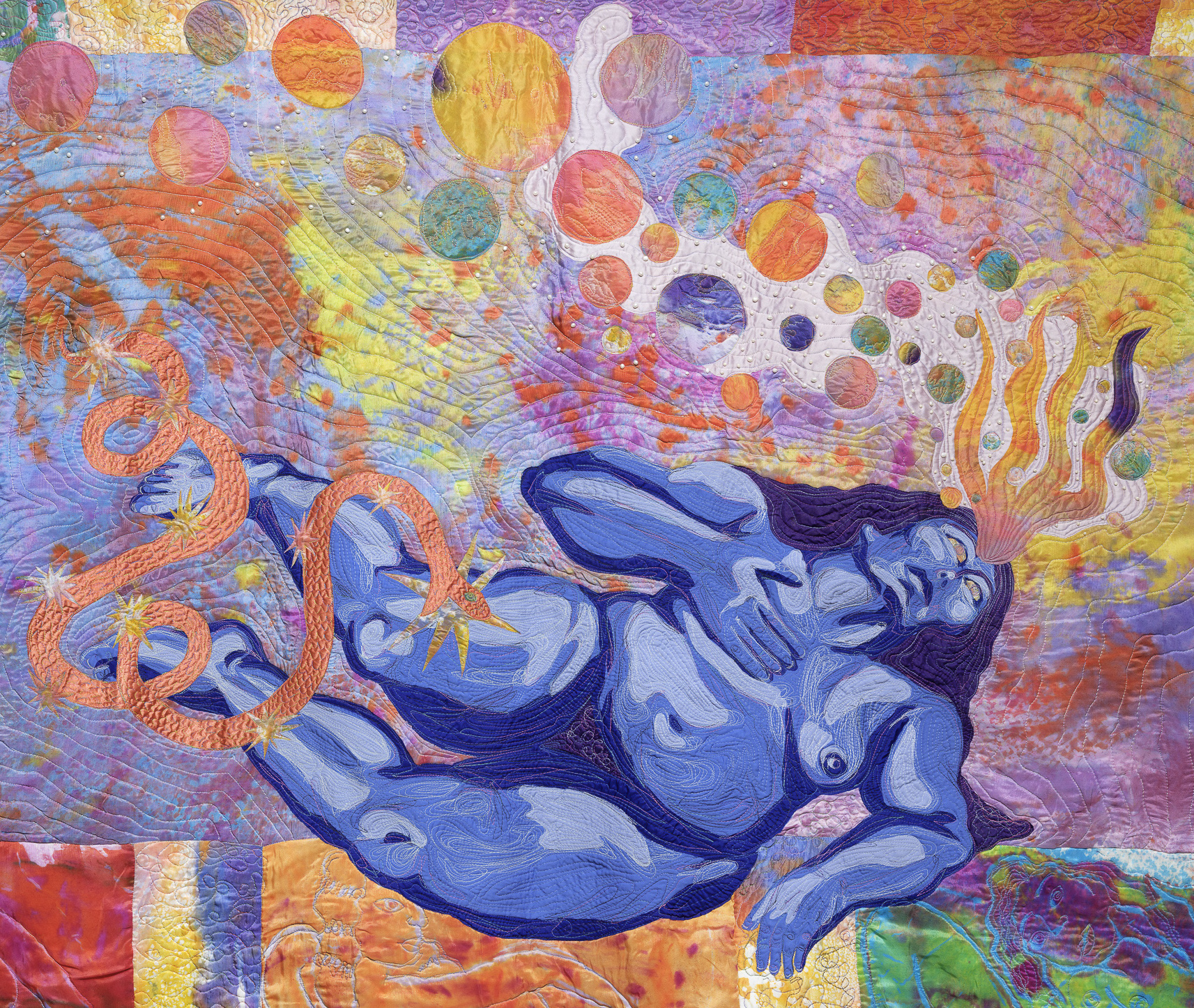
The Goddess, Asleep, Is Bitten by a Cosmic Snake and Thereby Hallucinates the Universe into Existence (detail), 2019-20
That sounds like a collectivist notion in favor of letting go of progress and individual ingenuity and power.
Yes absolutely. I'm sure somebody else has said this before, and this is me being a little bit cheeky, but it relates to ideas about sex and the narrative structure of sex, which tends to be very linear with a begininng point that starts with the cis male body and then an endpoint that is also determined by a cis male body.
Queer sex is not restricted by this linear way of thinking. This is not just a liberating way to think about sex and pleasure, but it's also an interesting parallel between concepts of time. Straight sex is like a straight line, and queer sex is spaghetti, or a switchback hiking trail, looping back onto itself.
Queer sex is not restricted by this linear way of thinking. This is not just a liberating way to think about sex and pleasure, but it's also an interesting parallel between concepts of time. Straight sex is like a straight line, and queer sex is spaghetti, or a switchback hiking trail, looping back onto itself.
Where does your interest in sci-fi come into your practice, and what kind of possibilities do you think it allows for?
I've always been interested in sci fi, I love Star Trek, the Alien movies–the bad ones and the good ones. Alien has a lot to say about, (whether accidentally or on purpose), assault and consent and abortion and women’s bodies and the bodies of workers under capitalism.
I think science fiction came into my work in thinking about ideas of death and futurity. Ursula K. Le Guin, who in addition to her fiction, wrote a lot of essays about science fiction that I find really exciting. I think the phrase she uses is “displacing our central moral dilemmas and time and space.” And discovering new things about these questions that we have for ourselves through creating new mythology; science fiction is very much contemporary mythology.
I love Star Trek, I think it's great, but there is a symptom within it that is indicative of limitations on our imagination, even in the context of science fiction which is about expanding those limitations. Gene Roddenberry, who created it, was in the Navy, and as much as he could imagine, or wanted to imagine this world that is very socialist in that they don't have money, and that there’s gender and racial equality, they're still basically in a military structure and hierarchy. It becomes an interesting way to think about the expansion and limitations of our imagination, or what we can imagine for the future.
I think science fiction came into my work in thinking about ideas of death and futurity. Ursula K. Le Guin, who in addition to her fiction, wrote a lot of essays about science fiction that I find really exciting. I think the phrase she uses is “displacing our central moral dilemmas and time and space.” And discovering new things about these questions that we have for ourselves through creating new mythology; science fiction is very much contemporary mythology.
I love Star Trek, I think it's great, but there is a symptom within it that is indicative of limitations on our imagination, even in the context of science fiction which is about expanding those limitations. Gene Roddenberry, who created it, was in the Navy, and as much as he could imagine, or wanted to imagine this world that is very socialist in that they don't have money, and that there’s gender and racial equality, they're still basically in a military structure and hierarchy. It becomes an interesting way to think about the expansion and limitations of our imagination, or what we can imagine for the future.
Dick Van Dick: Everything Louder Than Everything Else (detail), 2018
Visit Tura Oliveira’s artist page.
︎: @tura__oliveira

